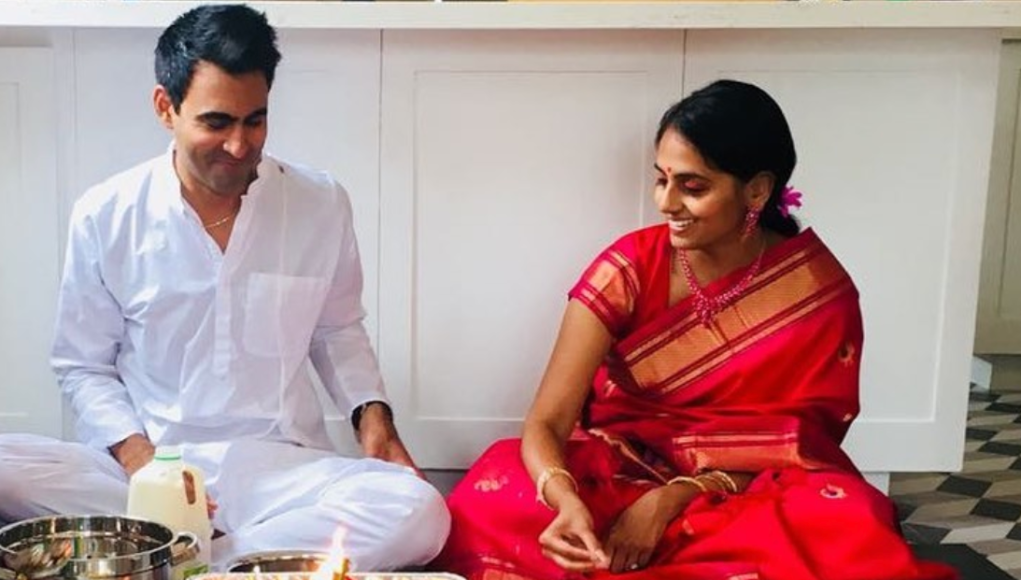Across the world and across generations, South Asian spiritualities have inspired a move toward new age wellness cultures. Western takes on Hinduism and Buddhism have become heavily commodified with messages of mindfulness losing translation as brands capitalize on selling what it means to “be well.” Furthermore, the stylistic take on many of these Westernized spiritualities prioritizes a minimalist aesthetic—think neutral tones, birch, and rattan. In the West, the spiritualities appropriated from the Global South become whitewashed and digestible. Freeing your mind is now associated with blank and empty spaces. In reality, this aesthetic movement has an appropriated spirituality that is originally extremely maximalist. South Asia is a vibrant place full of contrasting patterns, colliding colors and mismatched textures. Spirituality is internalized, not intellectualized. Joyful expression is externalized through decoration and design that maximizes a sensory experience, honoring the brilliant experience of life. The celebration of Diwali epitomizes this.
This weekend, many South Asian communities will gather to celebrate what is commonly known as Diwali or Deepavali, the festival of lights. Around the world families and friends gather in varying customs for a celebration that ritualizes the triumph of good over evil. South Asia is a region of vastly distinct dialects, ethnicities, and traditions. Diwali highlights the subcontinent’s diversities, drawing on a range of religious events, archetypes, and deities. From the commemoration of King Rama’s return to his kingdom after defeating Ravana to the reverence of Lakshmi, the goddess of abundance and prosperity, various sects of Hinduism, Jainism, Sikhism, and Buddhism commune in ceremony. Perhaps this lack of homogeneity is what has allowed the region’s stylistic choices to maintain as dynamically as they do.
Always coinciding with a new moon, the five-day-long festival brings together prayers, food, and fireworks, often taking days to weeks to prepare for. One thing is for certain, in all observing communities the lively adornment of sacred spaces, including the home and one’s altar, is a big part of this celebration. Living rooms and kitchens become the hub for festive feasting, draped in a multicolor of light and sound. Despite being miles away from their ancestral lands, diasporic South Asians continue to uphold this tradition across borders at a time where it feels paramount to cherish moments of communal gratitude. This year, the main Diwali festivity falls on Sunday, November 12.
We spoke to three South Asian creatives to learn more about their Diwali decor essentials and how to emulate a space that is true to its tradition when hosting in your own home. What you’ll notice is that all of them share a common thread of personalizing festivities with objects attached to specific moments and memories. Curbing the commodification of spirituality then becomes about a genuine and true understanding of where the practice comes from and why it’s maintained. In that way, meaningful Diwali decor cannot be bought or sold. Instead, traditions can be developed over time, ebbing and flowing with the seasons of life. Color is crucial, though!
Shriya Samavai, designer and founder of Samavai
Will be celebrating Deepavali this year with: Their cousin and partner in Los Angeles, CA
Shriya Samavai is a Tamil multidisciplinary artist based in Los Angeles. For Shriya, Diwali is more accurately known as Deepavali, true the Tamil name of the holiday. Growing up in West Lafayette, Indiana, for Shriya the festivity “feels like the South Asian Christmas.” “You get time off and get presents,” they say. In that way, Deepavali trascends religion and has become a cultural celebration.
This year, Shriya will be observing their Thalai Deepavali, the first Deepavali celebration after a couple is married. As the founder of a recycled fashion brand that is heavily inspired by the rich patterns and intricately designed textiles of their elders, Deepavali is a time for Shriya to commemorate the vibrant aesthetic quality of their South Asian heritage.
The adornment of a kolam in front of one’s home is a customary tradition that has influenced Shriya’s label Samavai. A kolam is the combination of rice flour and water, sometimes colored, sprinkled in geometric shapes in front of the doorstep. Kolams are a kaleidoscope of lines and colors and are said to bring prosperity, aligning with Shriya’s observation of Deepavali as a time to honor the goddess Lakshmi. “Of course, as it is the festival of lights, candles and lamps are the easiest way to create a space that emulates the spirit of Deepavali,” Shriya shares. “I make sure to pull out my grandmother’s kuthu villaku.”
They go on to highlight the importance of integrating traditional motifs in their contemporary celebration. A kuthu villaku is an oil lamp common in households throughout South India and northern Sri Lanka. Shriya’s stylistic commemoration of Deepavali quintessentially brings together new and old to create something beautiful in the present.
Aishwarya Iyer, founder and CEO of Brightland
Will be celebrating Deepavali this year with: Quiet mantras that reiterate the celebration of Deepavali inwards
Chennai-born Aishwarya Iyer grew up going to Deepavali parties hosted by family friends in her hometown of Houston. Now based in Los Angeles, she reminisces on Deepavali as “a time to eat a lot of sweets and wear new clothes.” Over time, Aishwarya’s practice of Deepavali has evolved as she’s honed in on what her own personal journey to her spiritual connection is.
“The light is not just around us, it’s also in us,” she explains. “The celebration of the light that exists in all spaces, externally and internally, is profound. The minute that became clear to me, I found a peace and clarity that made all the trappings associated with Deepavali fade away.”
Aishwarya alludes to the deep, lived connection many diasporic folks have to the embedded practice of compassion and unity inherent in the teachings of South Asian spiritualities. Her work with Brightland, a line of consciously made Californian olive oils and vinegars, fully embodies this mission. “Brightland as a brand is so bright and colorful, it communicates that light that I believe in,” she adds.
Last year, the brand released the Mini Artist Series as a tribute to the boxes of sweets she would see lining the dinner tables at Deepavali celebrations as a child. Lotus-printed, gold-leafed boxes of sweets known as mithai are a familiar sight at many Deepavali celebrations. As Aishwarya further explains, “Deepavali now is about finding my own way. Reminding myself of what’s been inviting and warm. Basing my celebrations around a singular memory.”
Michelle Ranavat, founder of Ranavat Skincare
Will be celebrating Diwali this year with: Her broader community, beyond her South Asian friends and family
For Michelle Ranavat, curbing the commercialization of Diwali means coming back to the purity of the celebration. The remembrance of Diwali as the honoring of good over evil is a priority. “Growing up, we spent time together as a family reflecting on the near year ahead and filling our minds and hearts with hope for the future,” Michelle shares.
Michelle grew up in Wisconsin, where Diwali was a lesser-known festivity, celebrated privately within the South Asian community. Now, she speaks with gratitude and joy at her ability to share it with her American friends at large. In particular, Michelle shares her excitement at experiencing the sensual quality of the celebration. Any Diwali function cherishing prosperity, expansion and growth is sure to be full of fresh flowers, highlighting the beauty of nature and its abundance.
Marigold floral garlands; roses in red, pink, and white; carnations; and mums are scattered across the dining table and altar. Both are spaces where people come together in sacred celebration. This year, Ranavat released the Sacred Jasmine Candle as an ode to the uplifting scent that commonly fills streets in South Asia, because no tablescape is complete without a candle or two. “Candles and scent create such a warm and welcoming vibe and it fills our home with hope,” Michelle adds.








